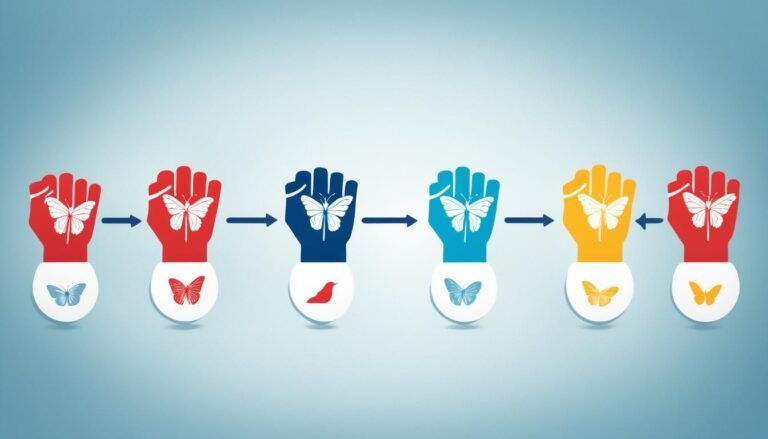How can conflict in teams be effectively managed?
Conflicts at work can make the U.S. economy lose around $359 billion each year. These fights hurt team work and lower performance. This article looks into solving team conflicts, handling them better, and how talking openly is key.
Key Takeaways:
- Effective conflict management is crucial for maintaining a productive team environment.
- Common sources of conflict in teams include poor communication, differing personalities, and opposing objectives.
- Open and constructive communication plays a vital role in resolving conflicts within teams.
- Strategies for resolving team conflicts include acknowledging the problem, identifying commonalities, and taking decisive action.
- Preventing conflicts in teams involves creating a positive workplace culture, fostering clear communication, and addressing the unique challenges of remote work.
Common sources of conflict in teams
Conflict often shows up when people work together in teams. This can slow down work and make the atmosphere tense. It’s vital to deal with these issues fast so everyone can get along better and be more productive.
Many conflicts in teams come from differences at work. This might be because people have different work styles or goals. If someone’s way of working doesn’t match, it could cause problems.
Bad communication is also a big factor. If people don’t talk clearly or listen well, things can get messy. Using clear channels to talk to each other helps, letting everyone know what’s going on.
People’s personalities can clash too, causing trouble. Everyone has their own way of doing things. It’s important to understand and respect how others work to avoid fights.
Team members aiming for different goals is a big issue. If they don’t agree on how to meet the same target, conflict can arise. It’s crucial to find a path that everyone can support to solve these issues.
Image:
The importance of communication in conflict resolution
Good communication is crucial in solving team conflicts. It’s the base for understanding and respect. Leaders who communicate well can overcome challenges. They foster talks that lead to the best solutions, taking into account everyone’s views and needs.
Listening well is a big part of great communication. When leaders listen, they learn what’s important to team members. This helps figure out why there is a conflict. With this insight, they can come up with solutions that really work.
Emotional intelligence is also key in resolving conflicts. Leaders who are emotionally smart can control their feelings. This helps create a space where team members feel safe and valued. In this environment, open discussions can happen.
“Good communication is the bridge between confusion and clarity.”
Problem-solving and communicating well go hand in hand. When team members talk openly, new ideas surface. This method encourages creativity and helps find new solutions to conflicts.
Team Alpha faces a conflict over project timelines. The conflict could get worse without good communication. Yet, their leader values listening, emotional intelligence, and problem-solving. They lead an open discussion. Each team member gets to share their thoughts and listen to others. Together, they find a compromise that works for everyone. Through good communication, Team Alpha becomes even stronger.
The Power of Constructive Dialogue
Having a talk where everyone respects each other’s views is essential. This leads to understanding and working together for common goals.
Here are some rules for good discussions:
- Taking time to truly listen to others.
- Thinking about how others feel and see things.
- Speaking in a clear, friendly way so there are no misunderstandings.
- Focusing on finding answers that everyone can agree on.
By following these rules, leaders can make conflicts stepping stones for growth. Encouraging open talks enables teams to face problems and get closer.
The Role of Problem-Solving in Conflict Resolution
Solving Problems is a big part of conflict resolution. It includes finding the real issues, looking at various angles, and making fair decisions.
Here are ways to problem-solve in conflicts:
- Figure out exactly what the problem is.
- Get all the important info and viewpoints together.
- Brainstorm lots of different solutions.
- Think about the good and bad of each idea to pick the best one.
- Put your plan into action in a clear and fair way.
Through solving problems well, teams can overcome conflicts. This helps create a happy and efficient work environment.
Strategies for resolving team conflicts
Resolving conflicts in teams is vital to keep a happy and efficient workplace. Key strategies include open communication, listening, acknowledging problems, finding common ground, making a plan, and taking action. These steps help managers solve conflicts effectively.
Creating open communication channels is the first step. Managers should promote face-to-face meetings. Here, team members can talk about their problems and views. This open discussion can help understand and fix conflicts.
Listening is crucial in resolving conflicts. It’s vital for managers to hear out everyone involved. Active listening shows empathy and helps managers understand the real causes of the conflict.
“Effective communication is 20% what you know and 80% how you feel about what you know.” – Jim Rohn
Next, acknowledging problems is key. Managers must accept and understand team members’ concerns. This step fosters empathy and encourages open talks for finding solutions.
Finding common ground is essential in conflict resolution. Managers should focus on what team members share, like goals and interests. Seeing these similarities can lead to joint efforts in solving conflicts.
Creating a detailed plan is also important. Managers and team members should work together to lay out a plan. This plan should tackle the main conflict causes and set clear steps for resolution.
But, a plan by itself doesn’t work. Managers must also put this plan into action. They need to make sure everyone follows the agreed solutions. This ensures the conflict is dealt with properly.
To sum up, conflict resolution in teams requires open communication, listening, problem acknowledgment, finding commonalities, planning, and action. These steps turn conflicts into chances for team growth and cooperation.
Preventing conflicts in teams
While conflicts are hard to avoid, leaders can stop many of them from happening. They can do this by making sure everyone speaks clearly, keeping the workplace friendly, and dealing with the challenges of working remotely. With these steps, teams can be built on trust and teamwork, which helps lower conflicts.
Fostering clear communication
In teams, talking clearly is key to stopping fights. It’s important to talk openly, listen well to what others say, and give helpful advice. This makes the work atmosphere open and everyone feels included. When everyone understands what’s needed and expected, there’s less chance for arguments or misunderstandings.
Avoiding over-reliance on emails for conflict resolution
Emails don’t always help clear up issues. Long email talks can end up confusing things, causing more problems, and harming how people work together. It’s better to talk directly, either in person or through video chats, when things get tricky. This gives a chance to clear things up right away, show feelings, and solve problems faster.
Creating a positive workplace culture
Having a positive place to work makes it easier for people to share their thoughts. Everyone feels valued and safe, which leads to better teamwork and less fighting. A workplace where people respect, listen to, and try to understand each other avoids many conflicts. Leaders should aim to build a place where respect, care, and everyone’s voice is important.
Addressing the unique challenges of remote work
Working from home has its unique problems that might lead to fights. It’s the leader’s job to help tackle these issues. They can do this by setting clear rules, making sure people can talk easily, and arranging activities that bring the team together, even if not in person. Making remote workers feel part of the team reduces chances of disagreements.
Building trust
Trust is crucial for team peace. When people trust each other and their leaders, they’re more likely to talk openly, work well together, and solve issues calmly. Trust comes from regular, honest talks, keeping promises, caring for each other, and making everyone feel they belong. These steps all create a safe and welcoming work environment.
By using these strategies, leaders can help their teams get along better. This means less time dealing with conflict and more time focusing on reaching their goals, being productive, and achieving success.
Conflict management skills for leaders
Effective conflict management is key for leaders. They need to use emotional intelligence, be impartial, and solve problems well. This mix helps stop conflicts from getting bigger. It also helps make the workplace peaceful and productive.
Leaders who are good with emotional intelligence can understand and control their feelings. They can also see things from others’ perspectives. This makes it easier for them to handle disagreements with care and understanding.
“Effective conflict management requires leaders to possess emotional intelligence and impartiality, allowing them to navigate conflicts with sensitivity and empathy.”
Being impartial is important too. Leaders must deal with disagreements fairly, without picking sides. This makes their team trust them more. It feels like everyone’s voice matters the same.
Having strong problem-solving skills is crucial. Leaders need to dig deep into conflicts. They should come up with new and smart ways to fix things. Seeing conflicts as chances to grow helps in finding solutions that work for everyone.
Leaders also stop conflicts from popping up in the first place. They create a space where it’s easy for everyone to talk. They make sure everyone knows the team’s goals well. This common understanding helps keep the peace.
To illustrate:
| Conflict Management Skills for Leaders | |
|---|---|
| Emotional Intelligence | Understanding and managing emotions, fostering empathy, and promoting open communication. |
| Impartiality | Approaching conflicts without bias or favoritism, treating all parties fairly, and creating a sense of trust. |
| Problem-Solving | Analyzing complex situations, identifying root causes, and generating creative solutions to resolve conflicts. |
| Preventing Conflict | Fostering clear and open communication, promoting team alignment, and addressing concerns proactively. |
By getting better at these skills, leaders can build a great work environment. They manage conflicts well and make their team stronger. This leads to more success for everyone.
Conflict management strategies in a hybrid work environment
In a hybrid work setup, combining in-person and remote staff, conflict can spike. This is partly due to the heavy use of digital communication. Leaders must put in place solid strategies to tackle conflicts. This keeps the work atmosphere peaceful.
Prioritize Face-to-Face Meetings
Digital talks often miss personal elements found in face-to-face chats. So, leaders should encourage in-person meetings or set up video calls. These allow for deeper talks. They let people share emotions and nonverbal cues, making communication clear and solving conflicts faster.
Provide Tech Support
Remote staff might run into technical problems that block good teamwork. Leaders need to ensure technical help is easy to get for these workers. By providing support and necessary tools, leaders empower their teams and cut down on tech-based conflicts.
Ensure Transparent Schedules
Keeping schedules clear is key for managing conflicts in a hybrid setting. When everyone knows when others are available, it’s easier to plan meetings or tasks. This avoids any mix-ups and helps with better schedule coordination.
Cultivate Trust
Trust is a big factor in handling conflicts and team success. Leaders must build it among their team. A trusting team can communicate openly, share views, and tackle issues together. This is done by setting clear teamwork expectations, offering support, and letting team members have a say in decisions.
Provide Remote Worker Coaching
Working remotely can come with its own set of obstacles, like feeling alone or struggling with the new setup. Leaders can help by offering specific training for remote work. This coaching guides on how to communicate well, manage time, and beat remote work challenges. By investing in this coaching, leaders show they’re invested in their remote staff’s achievement and help avoid potential conflicts.

By using these strategies, a hybrid workplace can see better team effort, fewer conflicts, and improved performance. Through focusing on face-to-face contact, providing technical help, keeping schedules clear, building trust, and coaching remote workers, leaders can shape a positive workplace. This environment encourages great conflict management and team triumph.
The role of values and objectives in conflict resolution
Workplace conflicts happen when people see things differently on how to reach common goals. Leaders must manage these conflicts well. They need to show how the issues affect the organization’s overall mission and values.
When leaders connect conflict solving with the company’s values, it helps a lot. This direction not only ends the conflict but also makes sure everyone is working towards the same goals. It makes the workplace more peaceful and efficient.
“Our values shape our actions and behaviors. When conflicts arise, it is important to consider how these conflicts align with our shared values. By addressing conflicts through the lens of our values, we can find solutions that not only resolve the immediate issues but also strengthen our team dynamics and relationships.”
Tying conflicts to the company’s mission and values makes everything clearer. It helps everyone see how their personal goals fit with the team’s and organization’s bigger picture.
Conflicts often arise when personal values clash with the organization’s. But by seeking common ground, leaders can lead the way to a better solution. They should encourage talks, listen actively, and aim for solutions that benefit everyone.
Benefits of aligning conflict resolution with workplace values and common goals:
- Promotes a sense of unity and shared purpose among the team members
- Fosters a culture of open communication and trust
- Encourages creativity and innovation in problem-solving
- Creates a positive work environment where conflicts are seen as opportunities for growth
The benefits of effective conflict management
Managing conflict well in a team can lead to major benefits. It helps the organization succeed and grow. When leaders handle conflicts right, it makes the team more committed, boosts performance, and encourages new ideas. It also promotes a happy workplace.
Engaged Team
Having an engaged team matters a lot for any company. When conflicts are sorted out well, team members feel important. They see that their views matter and are considered. This boosts their satisfaction and commitment to the team’s goals. Leaders who encourage open talks and provide a safe place for opinions can create a team that truly cares about its work.
Improved Performance
Solving conflicts well can take a team’s performance to new heights. It helps team members focus better on their tasks. They are not stopped by ongoing arguments. This way, they work together better, make smart choices, and do their jobs well. All of this leads to better work all around.
Growth and Innovation
Surprisingly, conflicts can spark growth and new ideas when managed well. By inviting different views and valuing feedback, leaders turn conflicts into chances to learn and be better. Healthy debates and fresh viewpoints often bring up new and smart solutions.
Positive Work Environment
Dealing with conflicts in a positive way helps create a great place to work. When issues are talked about openly and clearly, team members feel safe and supported. This builds a working culture of trust and teamwork. In such a place, people are happy to share their thoughts openly and without fear.
This kind of work environment boosts satisfaction, draws in great people, and keeps your best team members around. It’s a win-win for everyone. Overall, handling conflict well is key to a successful and happy team. It makes everyone better at their jobs, opens the door for new ideas, and builds a workplace where challenges are seen as chances for improvement.
Conflict management techniques and tools
Fixing team conflicts needs right techniques and tools. Team leaders can use different methods to create understanding, teamwork, and growth. Let’s check out key conflict management tips:
Analyzing the Root Cause of Conflicts
Root cause analysis goes deep into conflict reasons. It finds the real reasons behind disagreements. By doing this, team leaders can solve conflicts for the long term.
Defining Success Criteria
Success criteria are vital for solving conflicts. They set the goals for what success looks like. This helps everyone work towards the same goal. Leaders use success criteria to lead the team to resolve conflicts well.
Questioning Assumptions
Challenging assumptions is key in conflict management. It gets everyone to think critically and with empathy. Leaders make a space where different ideas are valued. This encourages finding new and smart solutions.
Examining the Impact of Solutions
It’s important to see how solutions will affect the team. This means looking at how fixes may change teamwork, happiness, and results. Leaders do this to make sure their choices help the team in the long run.
Switching Perspectives
Seeing things from others’ points of view is crucial. It helps understand other team members better. This fosters empathy and better talk. Looking at conflicts from many sides helps find the best solutions together.
Using these tips daily can reduce and prevent team conflicts. By focusing on the right analysis, success markers, assumption challenges, solution impacts, and perspective shifts, leaders can handle conflicts well. This creates a space where the team can work better and grow.
The role of monday.com Work OS in conflict management
Team conflicts can be hard to deal with. But, modern tech helps make it easier. A popular tool for this is monday.com Work OS. It has many features to help resolve conflicts.
monday.com Work OS is a full package for managing conflicts. It lets teams keep notes on behaviors, watch how conflicts are improving, and see solutions visually. With these tools, managers can handle conflicts well and keep the work environment positive.
Recording behavior patterns
Understanding why conflicts happen is key. monday.com Work OS lets managers note behaviors and find common issues. This approach helps teams see why conflicts start. Then, they can focus on solving the real problems.
Monitoring progress in conflict resolution
It’s important to know how conflicts are being solved. monday.com Work OS helps by setting up open and team-friendly steps. It’s easy to see how things are going, give out tasks, and follow the main goals. This keeps everyone accountable and ensures timely conflict solutions.
Visualizing solutions
Seeing possible solutions is really helpful in conflict resolution. monday.com Work OS has charts and boards for this. They let teams plan and see the effects of each idea. This clarity makes it easier to pick the best way to end a conflict.
In summary, monday.com Work OS is a great help for managing conflicts. It does everything from tracking behaviors to sorting out solutions in a visual way. This software gives teams the tools they need to handle conflicts well and keep the workspace positive and focused.
Conclusion
Conflict happens on teams, but it’s not always bad. There are ways to deal with it well. Prioritizing talking openly, solving problems, and finding solutions everyone can agree on helps. This approach leads to a better and more productive work setting.
Leaders are key in solving conflicts. They build trust and give the right tools to handle conflicts. By dealing with problems quickly and encouraging talks that make things better, leaders stop small issues from growing. This keeps the team and its work strong.
When conflicts are handled well, the work area becomes more positive. Teamwork gets better and new ideas might come up. Embracing different thoughts and working together to find unique answers can actually improve how well a team does its job.
FAQ
How can conflict in teams be effectively managed?
Conflict in teams can be handled well by figuring out what causes it. Then, teams should come up with ways to solve these problems. It’s also important to try and stop conflicts before they start. Talking openly, finding common ground, and working together are crucial.
What are the common sources of conflict in teams?
Many things can cause team conflicts. This includes things like not communicating well, different personalities, and goals. It’s vital to address these issues early. Doing so helps keep the team happy and working smoothly.
Why is communication important in conflict resolution?
Talking things out is key to solving conflicts. It helps leaders and team members see each other’s points of view. Listening well and understanding each other leads to better solutions. This is often more important than simply finding who’s right or wrong.
What strategies can be used to resolve team conflicts?
Managers can use several strategies to make peace in their teams. They should keep talking open and honest. Meetings must happen in person or via video, not just through emails. Everyone’s opinion is crucial. Together, finding common ground and making a plan moves things forward. Deciding clearly ensures the issue is actually resolved.
How can conflicts be prevented in teams?
Conflict can sometimes be avoided entirely. It helps a lot to have clear, direct ways of talking. Emails might not always be the best way to solve problems. A positive work culture that welcomes concerns is also key. Especially in remote work, trust and team relationships matter a lot.
What conflict management skills should leaders possess?
Leaders need to be good at many things to avoid conflicts. They should be good listeners and able to see things fairly. Solving problems swiftly and stopping new ones from coming up is crucial. Leading the team well and encouraging open talk helps keep peace.
How can conflicts be managed in a hybrid work environment?
In a mixed work setting, handling trouble can be done by picking the right times to meet and talk. Support for those working remotely is important. Making sure everyone knows what to do and can trust each other is crucial. Offering training helps remote workers and keeps the team strong.
What is the role of values and objectives in conflict resolution?
Team values and goals are like a roadmap to solving fights. They point everyone in the right direction. By making conflicts about these bigger goals, leaders can unite the team. This makes solving problems a team effort that boosts everyone.
What are the benefits of effective conflict management?
Handling conflict well turns a team into a happier, more innovative group. It lifts their performance and makes work a nicer place to be. By guiding conflicts into solutions, leaders help their team shine.
What conflict management techniques and tools can be used?
To deal with fights, start by looking at what’s causing them. Then, decide what success looks like. It’s also key to not take anything for granted and to think about consequences. Asking team members to see things from different angles is also helpful. Tools like monday.com Work OS can track behaviors and show the way forward.








